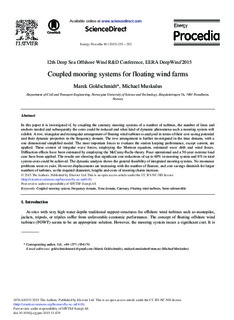| dc.contributor.author | Goldschmidt, Marek | |
| dc.contributor.author | Muskulus, Michael | |
| dc.date.accessioned | 2018-02-26T12:39:15Z | |
| dc.date.available | 2018-02-26T12:39:15Z | |
| dc.date.created | 2015-12-06T19:59:46Z | |
| dc.date.issued | 2015 | |
| dc.identifier.citation | Energy Procedia. 2015, 80 255-262. | nb_NO |
| dc.identifier.issn | 1876-6102 | |
| dc.identifier.uri | http://hdl.handle.net/11250/2487009 | |
| dc.description.abstract | In this paper it is investigated if, by coupling the catenary mooring systems of a number of turbines, the number of lines and anchors needed and subsequently the costs could be reduced and what kind of dynamic phenomena such a mooring system will exhibit. A row, triangular and rectangular arrangement of floating wind turbines is analyzed in terms of their cost saving potential and their dynamic properties in the frequency domain. The row arrangement is further investigated in the time domain, with a one dimensional simplified model. The most important forces to evaluate the station keeping performance, except current, are applied. These consist of irregular wave forces, employing the Morison equation, estimated wave drift and wind forces. Diffraction effects have been estimated by employing the McCamy-Fuchs theory. Four operational and a 50-year extreme load case have been applied. The results are showing that significant cost reductions of up to 60% in mooring system and 8% in total system costs could be achieved. The dynamic analysis shows the general feasibility of integrated mooring systems. No resonance problems seem to exist. However displacements are increasing with the number of floaters, and cost savings diminish for larger numbers of turbines, as the required diameters, lengths and costs of mooring chains increase. | nb_NO |
| dc.language.iso | eng | nb_NO |
| dc.publisher | Elsevier | nb_NO |
| dc.rights | Attribution-NonCommercial-NoDerivatives 4.0 Internasjonal | * |
| dc.rights.uri | http://creativecommons.org/licenses/by-nc-nd/4.0/deed.no | * |
| dc.title | Coupled mooring systems for floating wind farms | nb_NO |
| dc.type | Journal article | nb_NO |
| dc.type | Peer reviewed | nb_NO |
| dc.description.version | publishedVersion | nb_NO |
| dc.source.pagenumber | 255-262 | nb_NO |
| dc.source.volume | 80 | nb_NO |
| dc.source.journal | Energy Procedia | nb_NO |
| dc.identifier.doi | 10.1016/j.egypro.2015.11.429 | |
| dc.identifier.cristin | 1297441 | |
| dc.relation.project | Norges forskningsråd: 193823 | nb_NO |
| dc.description.localcode | © 2015 The Authors. Published by Elsevier Ltd. This is an open access article under the CC BY-NC-ND license (http://creativecommons.org/licenses/by-nc-nd/4.0/) | nb_NO |
| cristin.unitcode | 194,64,91,0 | |
| cristin.unitname | Institutt for bygg- og miljøteknikk | |
| cristin.ispublished | true | |
| cristin.fulltext | original | |
| cristin.qualitycode | 1 | |

